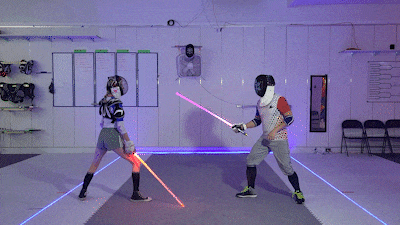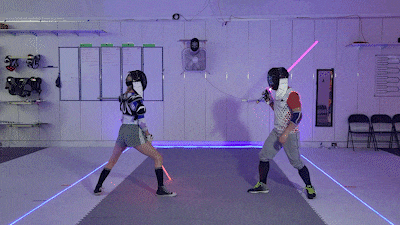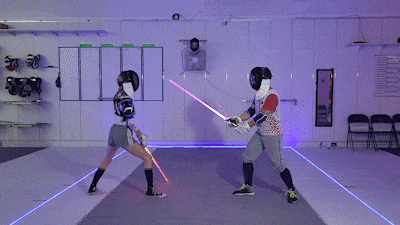The Lightspeed blade is a blunt object, capable of causing harm in unskilled hands; it is up to tournament staff to ensure that bouts stay under control. At the same time, overly strict referees can spoil what should otherwise be the world’s fastest light-based fencing. Here’s how to keep fencers safe, treat competitors fairly, and preserve our spectacular sport.
WHAT IS EXCESSIVE FORCE/POWER?
Be sure you’ve read the force protocol first.
POWER ENFORCEMENT THEORY (SUBJECTIVE-OBJECTIVE METHOD)
Lightspeed uses a “subjective-objective” method of power enforcement. It means that, to levy a power call (a formal citation of excessive force or recklessness against a fencer), the action in question must meet both a subjective and objective criteria.
Subjective criteria can include, by your personal judgment:
The attack making an exceeding loud sound on striking
The attack making an exceeding loud “swoosh” through the air
The attack being delivered at high velocity
The struck fencer genuinely expressing or indicating pain
Any combination of the above or general sense pointing to excessive force
Objective criteria can include:
Any blade-sign
Long sweeps (more info below)
In addition, some secondary objective criteria are listed below. These are less direct visual indicators than the blade-signs but are otherwise strongly associated with excessive force:
Locked out arms
Long attacks (chambered / wound up)
Sweeping attacks
Two-handed attacks
The subjective-objective method helps you enforce power in a consistent way. The objective portion ensures fairness, and the subjective portion helps prevent overly strict citations.
ENFORCEMENT GENERAL PROTOCOL
One of the key goals of the subjective-objective method is to be able to provide constructive feedback to the offending fencer, so that they can realize what they are doing that is wrong or of concern to you, and fix it. We do not assume that anyone is an intentional bad actor.
Once a fencer has triggered both criteria, halt the match immediately and make your citation (warning, violation, penalty cards, etc).
Explain to the fencer what objective criteria they have met that have elicited your citation.
Ask the fencer if they understand your citation. If they do not, explain it to them.
Give the fencer alternative techniques that you would consider acceptable.
Allow the match to resume, if applicable.
While you may cite subjective criteria, you should always have an objective criterion. All the objective criteria can be visually confirmed, and therefore can be taught on-site. Subjective cannot, nor can it be known to be fair nor consistent.
Attack strikes multiple targets on opponent
Attack bounces or strikes multiple times
Attack bends severely into opponent
Attack glances off or presses into target
Attack bounces, wobbles, or vibrates on the opponent
GENERAL GUIDELINES (long, short, percussive, and sweeping attacks)
Throwing a successful attack is easy. Throwing a safe attack is too. Throwing a good attack— one that is successful and safe— takes nuance and skill.
A good attack does two things: 1) accelerates rapidly to a specific target (not a whole person), and 2) brakes as the attack is arriving on the target.
Good attacks are also usually accurate, hit one target once, and usually do not needlessly windup or exceed the target.
But even wound up sweeps can be done safely and competitively.
WHAT IS BRAKING AND HOW SHOULD IT BE DONE?
Braking is the act of reducing the speed of an attack, usually just as it is arriving on the surface of the intended target area. This can be achieved with two primary methods: 1) a PERCUSSIVE CUT or 2) a DECELERATING CUT.
PERCUSSIVE CUT
In a percussive cut, the weapon accelerates to the target then rapidly accelerates in the opposite direction as it touches the surface of the target, returning more or less to its original position when the attack was initiated.
To perform a good percussive cut:
Accelerate your attack up to to the surface of the target (preferrably an armored one).
Quickly retract your arm or wrist and withdraw the weapon.
DO NOT leave the weapon extended after the contact (this is point-in-line, an illegal and unsafe position).




